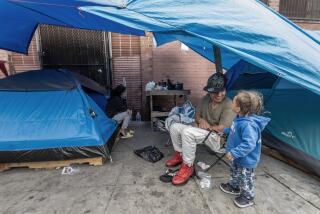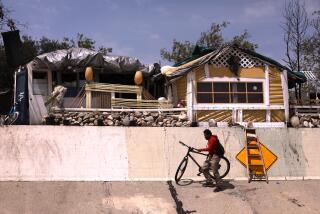L.A. County now has 58,000 homeless people. So why are there thousands fewer shelter beds than in 2009?
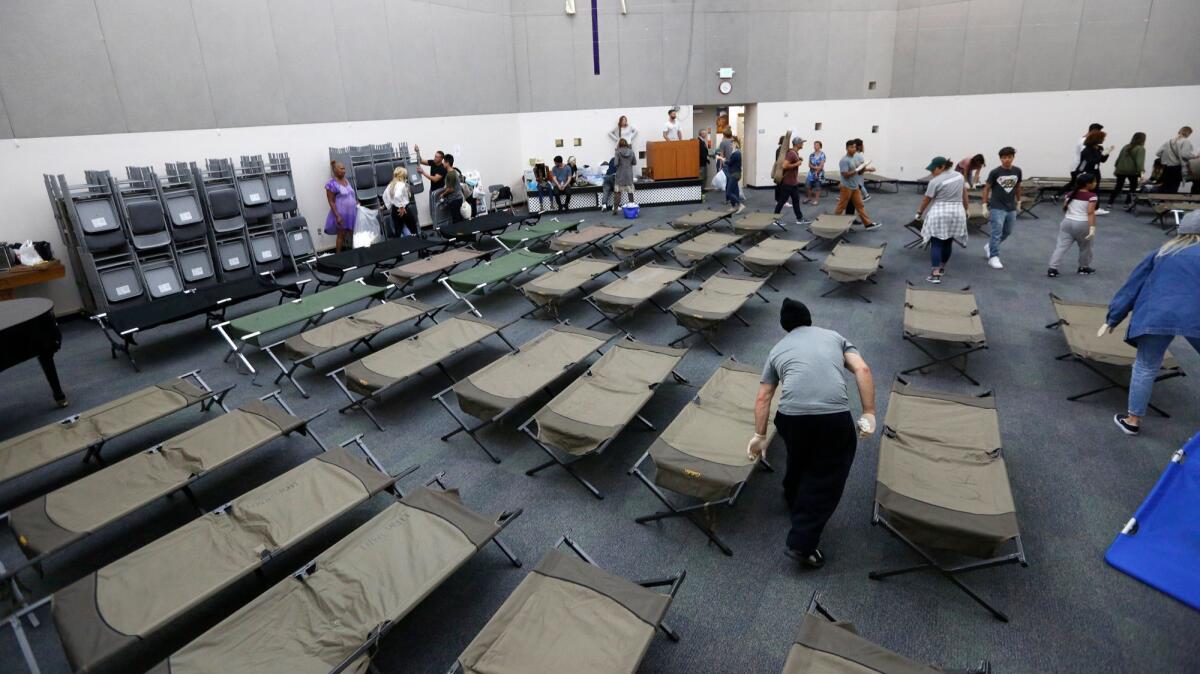
“Live from skid row, it’s Tuesday night!” Pastor Dan shouted, beginning two hours of Christian music and prayer for worshipers arrayed on metal chairs in the spacious, white-walled chapel at the Union Rescue Mission.
Once the playful service ended, worshipers folded and stacked their chairs and began to unfurl cots. There weren’t enough for everyone.
“Blankets and sheets on the floor,” the resident concierge at the chapel doors told latecomers who had waited outside for admission. “Blankets and sheets on the floor.”
By lights out, 1,300 people were bedded in the five-story building in the heart of skid row, women overflowing into the chapel and men on mattresses on the floor of the day room.
The crush of bodies at the Union Rescue Mission is a snapshot of the deficiencies in L.A.’s shelter network.
The county has one of the nation’s largest homeless populations, but its ratio of shelter beds to homeless people is among the nation’s lowest. There is no overarching shelter policy and no budgeting process to fund more shelters when homelessness increases. With rare exceptions, public agencies in Los Angeles do not build and operate shelters.
Instead, contractors operate facilities that range from a few cots in a church storage room to hundreds of bunks lined end to end in converted industrial buildings. They compete for a pot of local and federal money that has been shrinking in recent years.
“We do not have a standard for temporary subsistence housing,” said City Councilman Marqueece Harris-Dawson, chairman of the council’s Homelessness and Poverty Committee. “I don’t think we have ever admitted that shelters are a permanent part of our society even though they’ve been here for as long as history has recorded.”
Even as L.A.’s homeless population has surged in recent years, spurring voters to approve two tax measures, officials have de-emphasized shelters in favor of building new permanent housing and providing rental subsidies for market-rate housing.
Many L.A. officials say shelters do little to alleviate homelessness, arguing that they cost about the same as permanent housing and provide only brief respites from the streets.
So they have worked to reshape the shelter as a staging area where people stay briefly on the way to permanent housing. New funds have been directed toward bulking up housing and case management services at existing shelters rather than adding new beds.
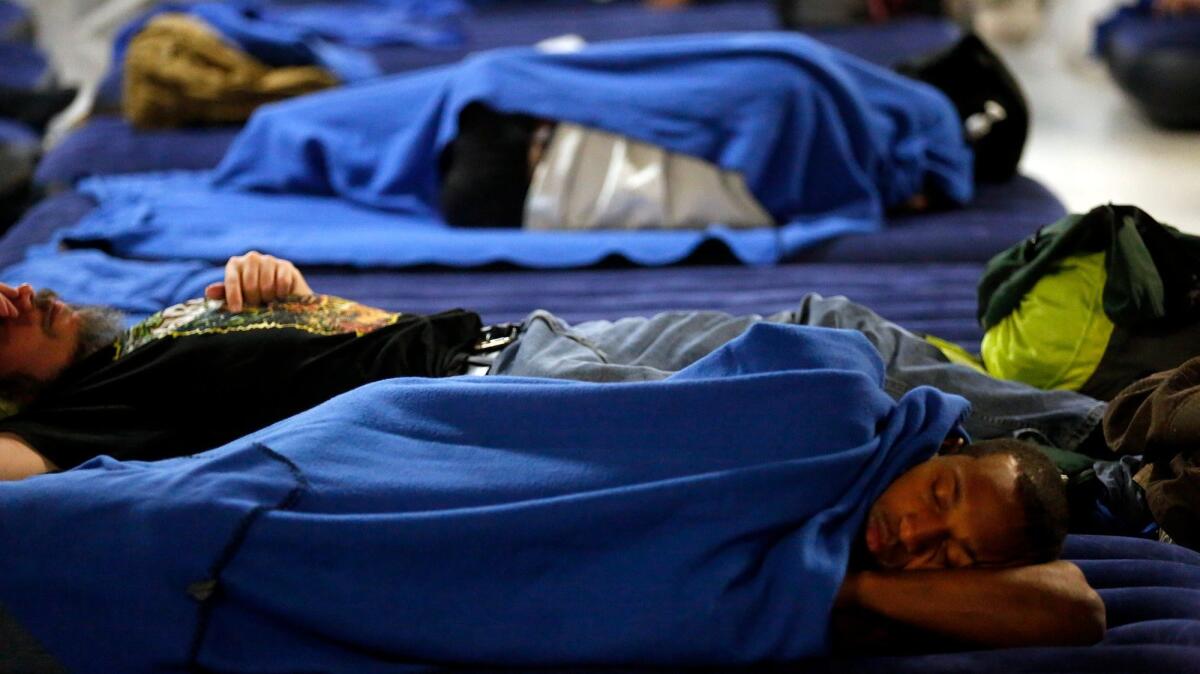
As a result, there is now only one shelter bed available for every four homeless people — one of the nation’s lowest shelter bed rates, according to a Times analysis of federal housing data.
By comparison, there are about three shelter beds for every four homeless people in the nation’s 402 homeless services areas, the data showed.
The data appear to cast doubt on the widely held view that homeless people won’t go to shelters. The closer a city is to providing a bed for every homeless person, the fewer of its homeless people were found to be “unsheltered,” the data showed.
New York City is required under the state’s “Right to Shelter” law to provide a bed for all its homeless people. The city has the nation’s largest homeless population — about 70,000 — but spends about $1.7 billion a year on shelters and is relatively free of sidewalk encampments.
“We’re very proud of that fact we do not have tent cities the way other cities do,” said Shelly Nortz, deputy executive director for policy at the Coalition for Homelessness, which filed the 1979 lawsuit that led to the law and remains the court-appointed monitor of a consent decree.
Seattle, Salt Lake City and San Antonio all manage to shelter a much higher share of their homeless populations than Los Angeles County, where 58,000 people are homeless, including 43,000 who sleep on the streets.
The number of shelter beds has declined over the last eight years, according to Los Angeles Homeless Services Authority records. In 2009, the authority counted just over 18,000 year-round homeless beds.
Of those, about 6,700 were emergency beds intended for stays of no more than six months, and more than 11,500 were transitional beds designed to allow clients up to two years to prepare for living independently.
By 2017 the total was down to just over 12,000 — 7,100 transitional and nearly 5,000 emergency beds. (Additionally, the Homeless Authority includes in its shelter count about 4,000 welfare and general-relief recipients who receive cash payments to stay in motels for up to a month.)
Few of L.A.’s roughly 280 shelters are in buildings designed for that purpose.
Aside from the long-established missions on skid row, there is one large shelter in the east San Fernando Valley and one in the city of Bell. The majority of others are scattered from the Eastside to South L.A., in facilities that include a converted hospital, single-family homes, warehouses, storefronts, armories and churches.
They average about 100 beds. The smallest has 12 and the largest — Union Rescue Mission — has 890 but routinely overflows.
Only about 60% of shelter beds receive money from the Homeless Services Authority, which distributes federal, county and city funds. The rest rely on private donations or cobble together grants targeting the mentally ill, veterans and parolees.
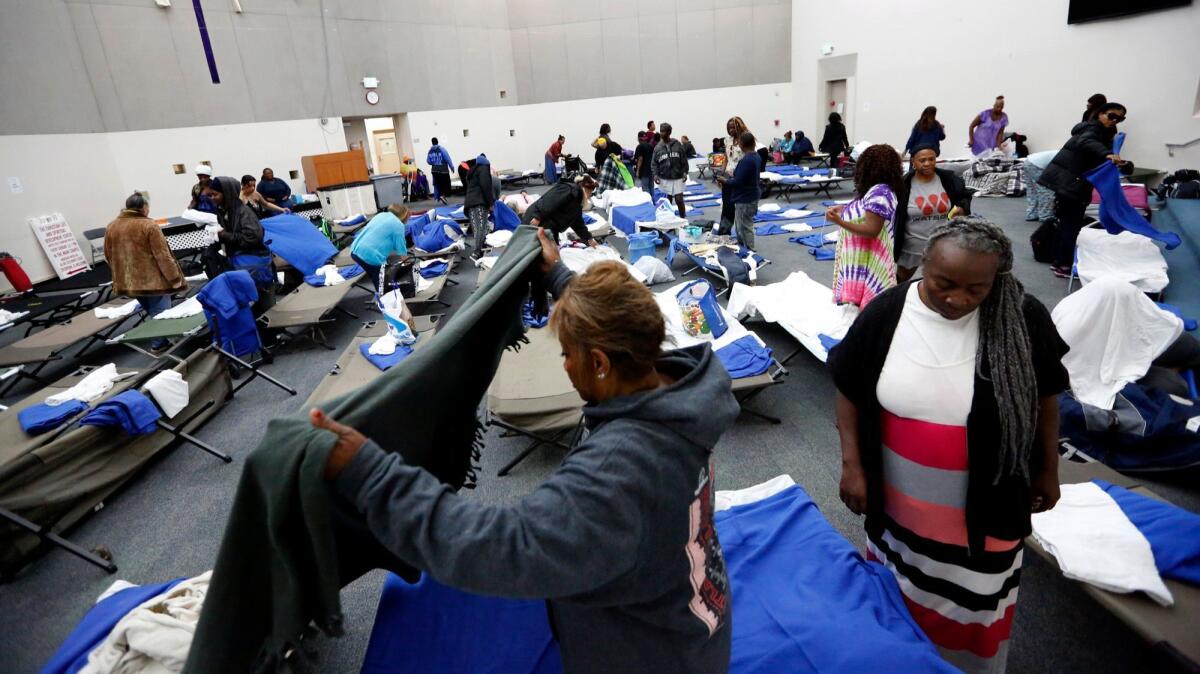
County voters in March approved Measure H, a sales tax increase that will bring in an estimated $355 million annually starting this fall.
A budget adopted in June by the county Board of Supervisors included $209 million over three years to improve the county’s shelter system.
But there are radically different visions of how that money should be spent.
For Andy Bales, chief executive of the Union Rescue Mission, nothing short of a crash program to get every homeless person off the streets is morally justifiable.
“I am haunted right now about the people who are on the streets,” Bales said. “I’m haunted by the families in South L.A. with kids wandering around with no place to stay.”
Bales and others who face homelessness daily want the city to adopt a New York model, with shelters for every person counted.
Local officials have far more limited plans.
“The simplistic response of saying, ‘Why don’t we put 47,000 people into shelter?’ — we’re not going to do that,” said Phil Ansell, head of the Los Angeles County Homeless Initiative, referring to the total from the 2016 count. “We’re not going to have anywhere near that kind of increase in shelter.”
I’m haunted by the families in South L.A. with kids wandering around with no place to stay.
— — Andy Bales, chief executive of the Union Rescue Mission
The plan adopted by supervisors in June allocates enough money for 2,175 new units for individuals and families over three years.
The budget projects that more than 11,500 additional people would receive shelter annually as a result, based on the assumption that the beds would turn over on average every three months as clients move on to permanent housing.
Even if that optimistic goal is met, it would make only a small dent in the county’s street population.
But officials project a further net reduction in shelter beds. A 2016 analysis by the homeless authority said adding 2,279 shelter beds would erase the current shortage. But it also foresaw the elimination of nearly 3,000 beds of transitional housing, which provides for stays of up to two years.
To make up the difference, homeless officials are counting on aggressive measures to build and subsidize permanent housing for the chronically homeless. The largest slice of the Measure H budget, $216 million over three years, is dedicated to rental subsidies to move people from shelters — or directly off the street — into permanent housing.
In moving away from traditional shelters, key players in Los Angeles have embraced the so-called “housing first” model.
It aims to quickly arrange permanent housing for chronically homeless people and support them through case management and other services.
The U.S. Department of Housing and Urban Development has made housing first a priority, and in recent years, the region’s most powerful advocacy groups — including the United Way of Greater Los Angeles, the California Community Foundation and the Los Angeles Area Chamber of Commerce — have aggressively promoted it.
They poured volunteer time and hundreds of thousands of dollars into Measure H, as well as the successful campaign for Proposition HHH, the city of L.A.’s $1.2-billion homeless housing bond.
Some housing-first advocates say shelters do a disservice to homeless people in the long run, by feeding and housing them without treating the mental or physical health issues associated with chronic life on the streets.
Elise Buik, president and chief executive officer of United Way, said shelters are sometimes so squalid that homeless people refuse to go to them.
“What frustrates me is there was for a while all this myth out there, ‘They don’t want to come in off the streets. They choose to be homeless,’” Buik said last fall during the Proposition HHH campaign. “We just found when we say, ‘Do you want to come into a shelter?’ they say no, but when we ask do they want to come into housing, they say yes.”
Money from the two tax measures is expected to provide 15,000 permanent units over the next decade.
For some service providers, that math doesn’t work.
”On the one hand that’s great,” said Pete White, founder of the L.A. Community Action Network. “However, there’s not enough shelter beds. We’re still decades away from housing every houseless person today.”
In 2015, the city and county increased funding, enabling the homeless authority to boost reimbursements for year-round shelters to $30 per bed per night, from $20.
The extra money allowed 18 shelters — with a total of more than 1,000 beds — to stay open 24 hours a day instead of 14, and to expand services.
The goal was to make shelter stays shorter by giving case managers more time with clients to work on housing. In theory, that would increase capacity without adding new beds, but the 23% rise in homelessness recorded this year has made it difficult to gauge any effect of the expanded hours.
A separate effort to create more beds sputtered this spring as city and county officials scrambled to extend the funding of 12 winter shelters scheduled to close in March. Ultimately, all but four of the sites closed.
The Homeless Services Authority, meanwhile, planned to add 1,075 new beds this year, but the effort is off to a slow start. The first step, a request for proposals, was not released until August.
Past notices have gone wanting as operators found that they could not beef up services in emergency shelters as required with the $30-per-night rate.
Christopher Callandrillo, the authority’s program director, said the rate will be bumped up to $40 per night, with some contractors getting $50 per night to support more intensive services.
Even then it isn’t clear there will be sufficient response to add 1,000 beds, Callandrillo said.
A prerequisite for obtaining a contract is having rights to the building the shelter will occupy. Few existing shelters have space to add beds, Callandrillo said, so applicants will have to find new locations that are both suitable for housing hundreds of people and acceptable to neighborhood groups.
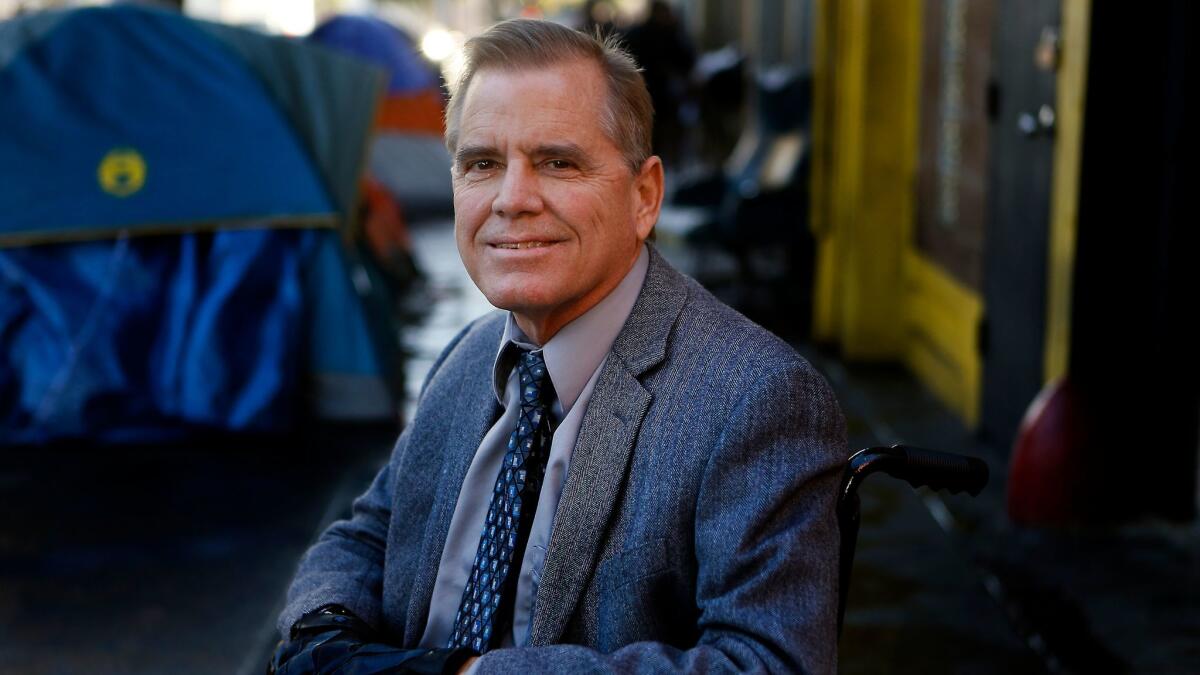
None of those efforts strikes Bales, as sufficient.
“We really should treat this catastrophe for what it is,” he said, “A catastrophe.”
His vision for bridging the shelter gap calls for tents around the city — big tents. The first would be erected on the mission’s surface parking lot on San Julian Street.
“We’re going to house 200 single women every night,” Bales said, adding that he aims to recruit other churches to put up tents on their parking lots.
If his plan is eligible for Measure H money, fine, Bales said. If not, that doesn’t dampen his ambition.
“You can get a weatherproof tent structure for a lot less than you can build a building,” Bales said. “It would only take a hundred 200-person tents to get 20,000 off the streets tonight.”
The idea is not novel. The city of Pomona is building a tent shelter on city-owned land. And on Wednesday, San Diego Mayor Kevin Faulconer announced a plan to erect three industrial tents to shelter homeless residents.
But as summer edged to a close, it wasn’t clear when the first tent would go up in Los Angeles. In a desperate message on his blog, Bales said donations are down so much this year that his plans to start construction July 1 were put on hold.
Now Bales may have to do something he’s never done — shut the door on shelter seekers.
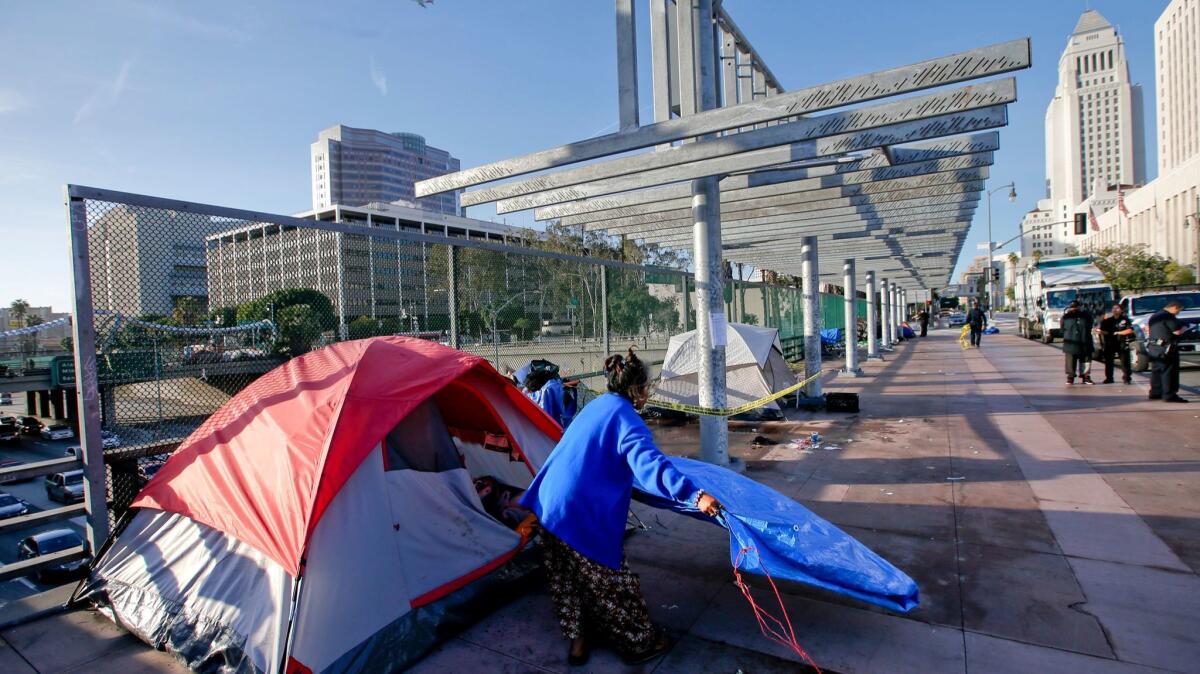
Many types of shelter
- The 17,801 Los Angeles County shelter beds in the January count were not all alike.
- 1,708 seasonal beds were open in December through March.
- Nearly half, 7,108, were transitional beds with stays of up to two years.
- 4,050 were funded by the Department of Public Social Services providing 16-day stays for welfare and general relief recipients with a possible 14-day extension.
- Only 4,953 beds were for crisis intervention.
Twitter: @LATdoug
More to Read
Sign up for Essential California
The most important California stories and recommendations in your inbox every morning.
You may occasionally receive promotional content from the Los Angeles Times.

